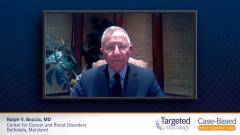
AR-Targeted Therapy for mCSPC: Adverse Events
Episodes in this series
Ralph V. Boccia, MD: Adverse events are part of any therapy that we use in oncology, and they certainly occur within androgen deprivation therapy and with apalutamide. Remember, TITAN is a randomized placebo-controlled trial, so it’s easy for us to compare what additional toxicity apalutamide might add to androgen deprivation therapy. There were several of them, some of which are unique. Fatigue can certainly occur. About a quarter of the patients had some degree of fatigue, but only on the order of 6% or 7% of the patients had a grade 3 or 4 fatigue. Fatigue can occur but tends to be relatively low grade. In addition, there were some unique things like skin rash. About 28% of patients developed a skin rash, which tends to occur relatively late. You’ve got to watch out for it during their continued course, on average a couple of months after initiating therapy. About 5%, 6%, or 7% of the patients can get a grade 3 or 4. It is something to watch for, something you may need to reduce for.
Falls and fractures. Remember, this tends to be an older population of patients, they may not have quite the same steadiness in their later years that they had in their earlier years, so falls can occur. If you fall, you can have a fracture. Could it have something to do with cognition? We’re not quite sure. But about 12% of the patients have falls in the apalutamide arm compared with about 7% of the patients in the placebo arm; it does occur with a higher rate. Same with the fractures—higher risk of falls, higher risk of fractures. None of them is very numerous, but they are nonetheless definitely significant.
And then seizures. We saw a few patients develop seizures in this trial. On the apalutamide, it was 0.4%, and on the placebo arm it was 0.1%. Seizures don’t occur with any frequency of either arm but certainly can occur with a higher frequency in patients on apalutamide. For that reason, it might not be the right drug for a patient who has epilepsy.
Transcript edited for clarity.
Case: A 66-Year-Old Male with Metastatic Castrate-Sensitive Prostate Cancer
Initial presentation
- A 66-year-old man presented with mild intermitted back pain
- PMH: DM; medically controlled; OTC analgesics for pain
- FH: No known family history of cancer
- PE: DRE revealed an enlarged prostate; otherwise unremarkable
Clinical Workup
- PSA 70 ng/mL
- Core needle biopsy with TRUS showed adenocarcinoma of prostate
- Gleason score (4+4)
- Bone scan revealed 4 spinal lesions (T8/T9, L1/L2) and 1 in the right femur
- Chest/abdominal/pelvic CT scan was negative for distant metastases
- Diagnosis: stage IV mCSPC
- ECOG PS 1
Treatment and Follow-Up
- He was started on ADT + apalutimide 240 mg qDay
- At 2-month follow up: PSA 10 ng/mL
- No new lesions on repeat imaging








































